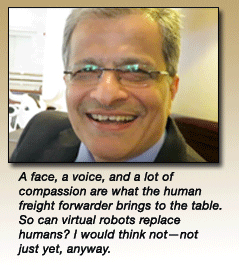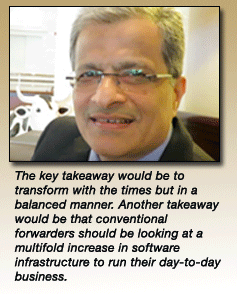 There are legions of “virtual
forwarders” entering the cargo business in 2017.
There are legions of “virtual
forwarders” entering the cargo business in 2017.
We recently spoke to a leader of the
international forwarding community for a reality check on the impact
VFs have on the industry. Keshav Tanna is a transportation innovator
whose impact is felt globally beyond his company base at Mumbai, India.
Tanna serves as Director at Links Forwarders
Pvt. Ltd.
He is also FIATA Vice President and Chairman
of the FIATA Air Freight Institute.
Digital
World Awaits
“The
industry,” Keshav said, “is no doubt headed in a direction
of digitization as customers desire information at the click
of a button and 24/7.
“The conventional forwarder has
recognized this and most have moved towards embracing the new technology.
“There has no doubt been a huge
impact on the industry with various kinds of electronic data exchange
platforms introduced in our industry.”
Delivering
Essential Services
“A
face, a voice, and a lot of compassion are what the human freight forwarder
brings to the table.
“The most touching line one of
my customers told me was that “if my cargo could speak, would
you not have been more careful?”
“A virtual forwarder has limitations
in delivering essential services, perhaps only offering a
help line or a mail box.
“By any measure, that limitation
is not what a customer wants to interact with, especially when
something goes wrong, or when a shipment requires hands-on attention
at short notice.
“These are limitations to a VF.
“So can virtual robots replace
humans?
“I would think not—not just
yet, anyway.”
Disruption
& Progress
“Digital
disruption is inevitable, and hence no doubt this has affected our thought
process in terms of things to come.
“However, with disruption comes
progress.
“While the conventional brick
and mortar freight forwarder will no doubt remain, our business
does need to move with the times and embrace technology to provide a
blend of both conventional as well as digital services.
“Digitization is the norm of the
day, as it serves multiple purposes in terms of accessing information
24/7; data storage and capture which avoids duplication;
process simplification; and most importantly transparency,” Keshav
Tanna declares.
 Counting
Days Of Change
Counting
Days Of Change
“I
do not think the traditional forwarder will perish (just yet) as
freight forwarding, as I see it, is a ‘people’ business.
“That said, change is inevitable
in our industry, just like it is in others.
“There is no doubt that people
cost money and business is all about money.
“So digitization will increasingly
replace some of the manpower for the traditional forwarder to remain
competitive.
“The key takeaway would be to transform
with the times but in a balanced manner; over the years, telephonic/personal
interaction has seen a downward trend as online information access has
become the norm of the day.
“Another takeaway would be that
conventional forwarders should be looking at a multifold increase in
software infrastructure to run their day to day business.”
Again
The Human Factor
“In
terms of day to day experience, while customers simply love the
pricing/process capabilities that a VF can offer, their biggest complaint
I hear is that they are ‘just a number!’
“Very limited personal interaction
sometimes loses the feeling of touch and in a people business that
could be a turning factor.
“In terms of IT platforms, most
traditional forwarders are now up to speed; track and trace
has now advanced to a stage of a mobile app the forwarder provides to
his important customers. However, more importantly, customers now want
to go two steps further and talk directly to our systems on a real time
basis.
“Many conventional forwarders do
offer system access to their leading customers. Such access offers real
time visibility to shippers from the moment the cargo leaves their warehouse
until it has been picked up by the consignee at destination or door
delivered at destination as the case may be.”
The
Pricing Challenge
“One
of the major challenges a conventional freight forwarder faces is in
terms of the pricing platform the VFs provide.
“Customers are able to access negotiated
rates at the click of a button with utmost transparency.
“This activity is being used against
the conventional forwarder time and again to lower prices.
“I do not know how much of e shopping
you do, but I have noticed a peculiar phenomenon when one tries to buy
the same product the third or the fourth time - the price “rises”
with each buy - the algorithm kicks in and it recognises your favourite
product (perhaps will be a trade lane in case of VF developed software…)
As they say, there are no free lunches. ”
The
Reality Check
“Yes,”
Keshav smiles, “a Virtual Forwarder is only as good (or as mediocre)
as his software allows him to be.
“Also, it should be mentioned VFs
have rarely encountered critical situations face to face, whereas the
real life forwarders have ‘been there and continue
doing that’ day in and day out.
“Taking a wider view, corporations
have daily war-like situations in their boardrooms, which is where
a real flesh and blood forwarder backed and supported by a decent software
offering has opportunity to lead the way and come out ahead.
“Put another way, we fly by the
seat of our pants and face real life situations on a day-to-day basis,
but the thrill of a three-point touchdown makes everything worthwhile
and the customer happy.
“No pain no gain, as they say!”
Streamlining
& A Bump In The Night
“Algorithm
platforms are a reality; they are no doubt useful for streamlining processes,
but have limitations in terms of having set rules to solve set problems.
“The question is whether a customer
will always have a problem that can be solved by a set of pre-determined
steps?
“In fact, when there is the smallest problem,
most of my customers would like to hear a voice on the other side telling
them how the problem can be solved.”
“But beyond that, in most cases
the shipper wants to hear the voice of somebody senior in customer service,
rather than that of a help line.
“This is where a Keshav Tanna would
be different from the others.
“In our organization, one of the
most important SOP is the one where a customer is on the line with a
problem!
“In fact, this is the time when
they need me and I should be available.
“That’s where I come in and
where I need my inbox to be involved.
“When the going is good, I don’t
need a pat on the back.
“But when things get sticky, I
want to be the first to know, as that is the time my customer needs
me the most.”
Looking
Ahead At Changes
“If
the traditional forwarder does not embrace technology and chooses to
live in the past, he will perish, no doubt about that!
“There is a ‘real’
challenge from the ‘virtual forwarder’ and there is
no running away from it.
“But I believe family businesses
that have continued to survive over the years will evolve.
“Many conventional forwarders
who think it may be enough to invest in people need to understand that
investments in systems and technology is a reality in 2017.
“As vital to our business as people
are, alone we cannot take our business to the next level.
“I have no doubt that the traditional
forwarders will continue to survive in this highly competitive
environment because we sell a service and hence the human touch cannot
be completely ignored.
“Back our effort with enhanced
technologies and competitive pricing and we are here to stay!”
Keshav Tanna said.
Geoffrey




 Vol.
16 No. 70
Vol.
16 No. 70 Vol.
16 No. 71
Vol.
16 No. 71